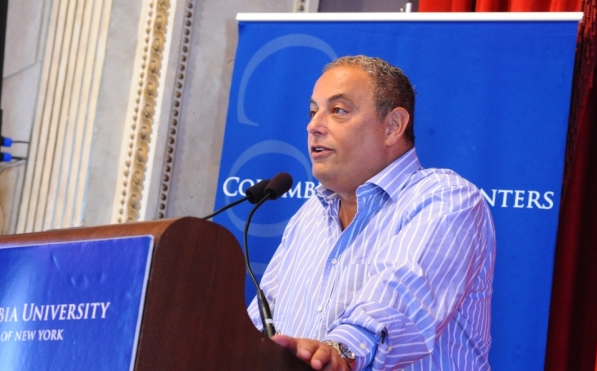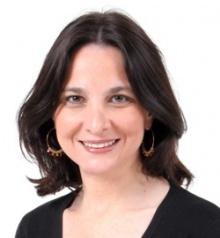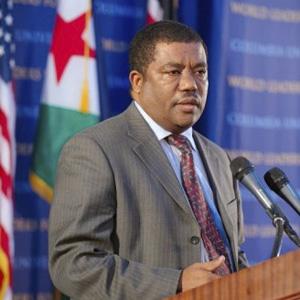Internationalism Evolves: Columbia and the Global Centers
This is excerpted with permission from the original story, written by Alexander Gelfand and published in the Spring 2013 issue of Superscript, the magazine of Columbia University's Graduate School of Arts and Sciences.

From his office on the 14th floor of the School of International and Public Affairs (SIPA), Paul LeClerc, Ph.D. ’69 and director of the Columbia Global Center | Europe in Paris, straddles two major periods in the history of Columbia’s engagement with the wider world: one of them rooted in a model of internationalism that stretches back to the early days of the 20th century, the other arising from more recent notions of global interconnectedness and interdependency.
The Paris site is part of a network of eight Global Centers that serve as hubs for University activities across a broad geographical swath. (The other seven are located in Amman, Beijing, Istanbul, Mumbai, Nairobi, Rio de Janeiro, and Santiago and represent, respectively, the Middle East, East Asia, South Asia, Africa, and Latin America.) Mark Wigley, dean of the Graduate School of Architecture, Planning and Preservation, whose own worldwide network of Studio-X facilities is closely integrated with the Centers, views each site as a “broadband platform for supporting every possible kind of interaction between Columbia and a region,” and as a “high-level exchange node that accelerates and facilitates new forms of collaboration.”
That very modern model represents the extension, one might even say evolution, of an earlier approach to internationalism. SIPA, for example, was one of many University institutions that grew out of the need for foreign intelligence during World War II and the subsequent Cold War demand for regional expertise, phenomena that led to the field of area studies as we know it today. SIPA’s offices are just a short walk from Deutsches Haus and the Maison Française—the oldest foreign-language or cultural houses in the United States. Both were inaugurated in the early 20th century by University President Nicholas Murray Butler, a Nobel Peace Prize winner who advocated for what he called “the international mind”: a habit of regarding “the few nations of the civilized world as free and co-operating equals in aiding the progress of civilization, in developing commerce and industry, and in spreading enlightenment and culture throughout the world.”
Such institutions continue to play a vital role in the life of the University and of many students and faculty. LeClerc himself is chair of the advisory board for the Maison Française, which will celebrate its 100th anniversary in 2013. Yet as director of one of eight Global Centers located on four continents, LeClerc is also part of a very different kind of international initiative: one that focuses less on exporting knowledge than on accruing it; one that uses area studies to understand the relationships between participants in a larger global system; one that is less interested in bringing the world to Columbia, and more interested in expanding Columbia’s presence in the world.
Expectations are high. Administrators expect that activity across the network, in the form of communication and collaboration among the Centers, will become at least as important as activity within the Centers themselves, creating what Wigley calls an “intellectual framework” along which ideas will spread in unexpected ways, like plants along a trellis. Ultimately, he muses, the entire structure may come to resemble a “thinking machine that will begin to think in ways that we can’t predict.”
“The world has been interconnected since ancient Rome, at least,” says LeClerc, who also serves as a visiting scholar in the Department of French and Romance Philology. “But the dimensions of interconnectedness that we have in the world today are staggeringly complex, and affect the lives of people around the world on a continual basis—and not in a way we’ve ever seen before.”
Consequently, university administrators have come to the realization that while traditional approaches to internationalization (recruiting foreign students, establishing study abroad and exchange programs, promoting area studies) remain valuable, they are no longer sufficient.
Getting It Right
Many American universities have built branch campuses in other parts of the world. A recent census by the UK-based Observatory on Borderless Higher Education counted 200 such campuses, 78 of them operated by American universities, many of them located in developing countries in Asia and the Middle East. There are many flavors of overseas branch campus: a 2009 survey by the American Council on Education found that some receive full or partial funding from their host governments, while others receive none; some offer only graduate or undergraduate programs, others both; and some partner with foreign universities, while others go it alone.
Yet Columbia, unlike many of its peer institutions, has resisted this particular approach to expanding its global footprint. At a roundtable discussion held during the World Leaders Forum in September, University President Lee Bollinger told a group of undergraduates and graduate students that when asked to explain what the Centers are, he finds it easier to explain what they are not. And what they are not, Bollinger said, are branch campuses.
There are many reasons for this. For one thing, the long-term viability of the branch campus model remains in question. Many have suffered from underenrollment, and a few, including George Mason University in the United Arab Emirates and Michigan State University in Dubai, have collapsed entirely. Faculty are often unwilling to uproot themselves and their families for a year or more in order to serve abroad, and it can be difficult to attract the same quality of student at a branch campus—all of which, in turn, can dilute the quality of a university’s brand.
For another, some academics object to the very notion of exporting an American approach to higher education in order to make money off the backs of students in the developing world—a practice that raises the specter of the dreaded “i” and “n” words.
“The whole point of the Global Centers is to follow an approach that is not imperialist and neocolonial,” Safwan Masri, director of the Global Center | Middle East in Amman, Jordan, said when he took the floor after Bollinger at the September roundtable.
“The branch campus model is really about parachuting in, teaching students, and then getting out,” Masri, who was named vice president for Global Centers in July 2012, later elaborated. “There’s nothing about the host country or region benefiting from the experience in a way that is sustainable, in a way that helps it become independent, and thus a net contributor.”
By contrast, the Centers were never meant to serve as one-way channels for “spreading enlightenment and culture throughout the world,” to use Butler’s phrase.
As an example, Masri points to the Queen Rania Teacher Academy, an independent Jordanian institution housed within the Amman Center that was established in partnership with Teachers College under the patronage of the Queen. With the Center’s help, the Academy offers teacher-training programs tailored to the Arab world; thus far, it has reached more than 2,500 educators.

“We’re helping the Academy, we’re helping the country, we’re helping the region develop expertise,” says Masri. “We want to create organizations that will not only be partners with us in this transfer of knowledge phase, but that will be peers for us in the future.”
A principal goal of the Centers is to foster new relationships across the various schools and disciplines represented within the University. In keeping with that aim, the Amman Center has also established an Institute for Sustainable Development Practice in collaboration with the Jordanian Ministry of Planning and the Earth Institute, a Columbia-based organization led by Professor Jeffrey Sachs that joins with local governments, the United Nations, and others to find solutions to pressing global issues such as poverty and climate change.
The Center is also helping to advance public health and social work in the region through partnerships with the Mailman School of Public Health and the School of Social Work. Similar cross-disciplinary and capacity-building programs coexist alongside the more traditional research activities undertaken at the other Global Centers.
“Our model is about learning. It’s about a two-way exchange of knowledge and skills,” says Masri, who like his fellow directors alternately describes the Centers as platforms for interdisciplinary research, vehicles for new educational opportunities, and instruments for seeking solutions to global problems.
Flexible Roots, Rapid Growth
“The fundamental idea from the beginning was that there was no such thing as aGlobal Center,” Prewitt says. In 2005, President Bollinger announced the creation of the Committee on Global Thought, led by Nobel Prize winner and University Professor of Economics Joseph Stiglitz, whose official purpose was to “reconceive, and find new ways to support, the project of making Columbia University a genuinely global university in the century ahead.”
The committee, itself the product of an earlier Task Force on the University and Globalization, introduced new courses and research initiatives and enabled what Masri describes as “globally focused conversations” on campus. The Centers comprised the next logical step in Columbia’s path toward globalization: a physical and intellectual infrastructure for global studies that would push beyond the boundaries of New York City.
The essential idea was to establish a web of interconnected facilities in major world regions, as opposed to a clutch of isolated satellite campuses, and to ensure that all of those centers would be accessible to, and in fact used by, the entire University.
The network has grown rapidly, from two Centers in 2009 to eight in 2012, with schools from Mailman to GSAPP engaging in joint projects. “Would any of us have thought we’d have come that far in three years? No. But it happened because it was the right idea,” Prewitt says.
It is also an idea that continues to evolve. At the September roundtable, which capped a week-long Columbia Global Centers Directors’ Summit, each of the eight directors was seated at a table full of students.

Karen Poniachik (M.I.A. ’90), the SIPA alumna who directs the Global Center | Latin America in Santiago, pressed her tablemates relentlessly on what might raise interest in, and awareness of, the Centers on campus and how they could be made more accessible to students. Masri said that he intended to use the feedback gathered at each table to generate new initiatives—“marching orders,” as he put it—and hoped to recruit some of the attendees to serve on a student advisory council.
Along with such efforts to improve and refine the Centers, attempts are being made to routinize at least some aspects of the network. In his first year as vice president, Masri, who is an expert on operations management, aims to standardize such things as branding and governance—albeit without hindering innovation or breeding conformity.
“How we do things needs to be uniform across the Centers, but what we do should not be,” he says. (Other goals include broadening engagement with the various schools within the University; developing a set of global themes, such as health and education, that the Centers can work on together; and designing a standard business model for the Centers, which are currently funded through a mixture of project funds and donations from foreign alumni and friends of the University.)
To Each Their Own
Given their present level of diversity, there seems little chance that the Centers will become overly homogenized.
The Amman Center, which serves as a model for the others in terms of the range of its programs and partnerships, occupies a 45,000 square-foot building with its own auditorium, conference rooms and classrooms, and offices for 24 full-time staff. An upstairs wing houses the Amman Lab, GSAPP’s local Studio-X facility—this past summer, 20 students from the United States, Jordan, and Turkey gathered there and in Istanbul for a two-week workshop on designing public spaces—and the site has its own teaching annex, information technology office, and communications team.
The Paris Center, meanwhile, occupies 23,000 square feet in Reid Hall, a former porcelain factory on the Left Bank that has served as the University’s foothold in France for more than half a century.
“It has been an extension of Columbia for 60 years,” says LeClerc. “It is an academic center, and it's a center of study. You can do an entire M.A. program there. You can do two M.A. programs there. Over a thousand Columbia students have gone and spent a semester or a year there.”
In August the Center, which employs 14 people, announced that it would be the first in the network to host a group of postdoctoral fellows. In September it was named the home of the Secretariat of the United Nations Sustainable Development Solutions Network, an Earth Institute–affiliated project that aims to mobilize experts in academia, civil society, and the private sector to help solve global problems. In September 2013, the Center will host the inaugural World Writers’ Festival, presented by Columbia University and the Bibliothèque Nationale de France and supported by Le Monde.
Contrast that with the Santiago Center, which was launched in March 2012, takes up 4,000 square feet of office space, and employs three full-time staffers.
Despite being one of the youngest and leanest of the Centers, however, the Santiago site sees plenty of activity. The Center shares a faculty steering committee with its counterpart in Rio, and a number of committee members have visited over the past year, doing research, teaching at local institutions, and advising the Chilean government.
“They have a lot of expertise in the region in different areas—human rights, political science, trade—and they can provide a lot of contacts in Chile and in the region,” Poniachik says.
Poniachik herself is pretty well connected: a former minister of mining and minister of energy in Chile who also served as the country’s special envoy to the Organization for Economic Cooperation and Development, she has contacts in government, business, and academia. So far she has helped establish a partnership between the Ministry of Agriculture and the Earth Institute’s International Research Institute for Climate and Society to respond to extreme weather such as floods and droughts; assisted in brokering an agreement between Columbia and the Chilean government over scholarships for Chilean graduate students accepted to the University; and facilitated a partnership between SIPA and the School of Economics and Business at Universidad de Chile to offer a summer executive training program on regional and international finance topics.
The Center also coordinates field placements in Chilean mining communities for students in the Master of Public Administration and Development Practice program run jointly by SIPA and the Earth Institute. Caroline Ocampo-Mayo, one of two students who traveled to the Andean mining town of Andacollo last summer to identify sustainable development opportunities for Teck, a Canadian company that operates a large copper mine in the area, credits Poniachik and the Center for helping her make the most of the ten-week-long research trip.
Ocampo-Mayo says that Paula Pacheco, the Center’s assistant, arranged meetings with Teck managers in New York, and with officials in Chile, while Poniachik played the role of in-country academic advisor, “helping us to navigate the system, establishing an interesting agenda, and helping us open doors and meet people.” Poniachik even provided feedback on the team’s final research paper, which included specific recommendations for creating new educational and employment opportunities that would benefit both the mining company and the town.
The Africa and South Asia Centers, meanwhile, coalesced around a clutch of pre-existing Earth Institute projects and remain closely associated with them. As Joanna Rubinstein, assistant director for international programs at the Institute, explains, what ultimately became the Nairobi Center in September of 2012 had for some time been the Institute’s own beachhead in Africa for advancing the United Nations’ Millennium Development Goals, which include halving hunger and extreme poverty, ensuring environmental sustainability, and providing universal primary education. Today the MDG Center for East and Southern Africa is formally housed within the Global Center | Africa, which operates MDG-related projects in 14 different countries.

According to Center director Belay Begashaw, a former Minister of Agriculture for Ethiopia, the Nairobi site focuses on finding technical solutions to local problems, like using bed nets to fight malaria in Malawi, and then helps sell those solutions to national-level policymakers. Three countries have already adopted measures recommended by the Center, and Begashaw believes that the transition from Earth Institute venture to networked Global Center “will really change significantly the programs here, and Columbia’s visibility in Africa.” A number of University units, from Mailman to the Department of Ecology, Evolution and Environmental Biology (EEEB), are undertaking programs with Center support; a group of EEEB students will arrive in January for a three-month seminar on tropical biology and sustainability led by faculty from both Columbia and Princeton University, and the latter has shown interest in establishing a joint research program.
Wigley, at GSAPP, believes that such exchanges will help turn the University from a place where “brilliant people and ideas come together and are sent off into the world” into an institution characterized by the kind of “distributed intelligence” that is more relevant to a globalized world.
“I think the Global Centers are quietly putting in place the beginnings of what could be an almost explosively rich series of forms of teaching, of exchanging knowledge, of learning, of laboratory work,” he says. “Over time, very beautiful things will come out of this.”
